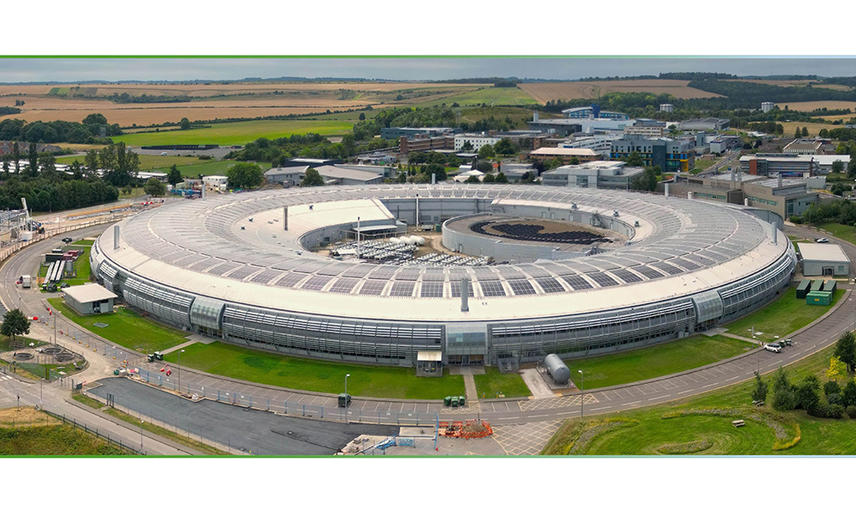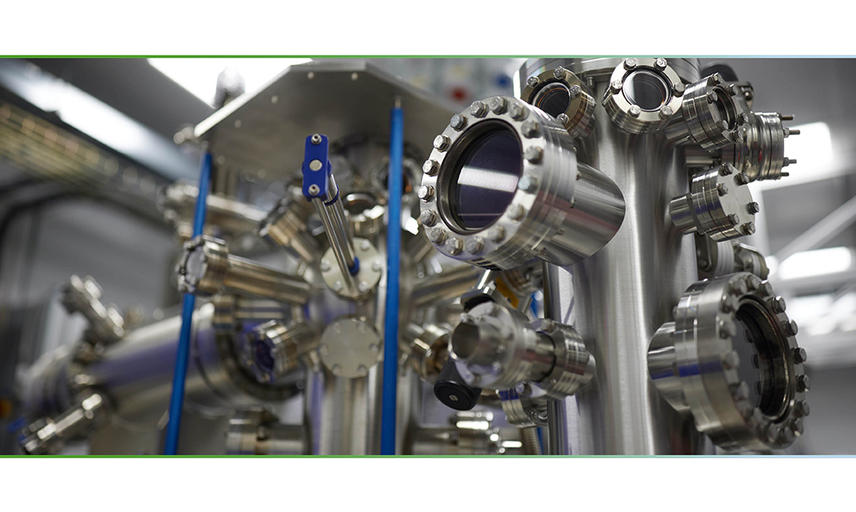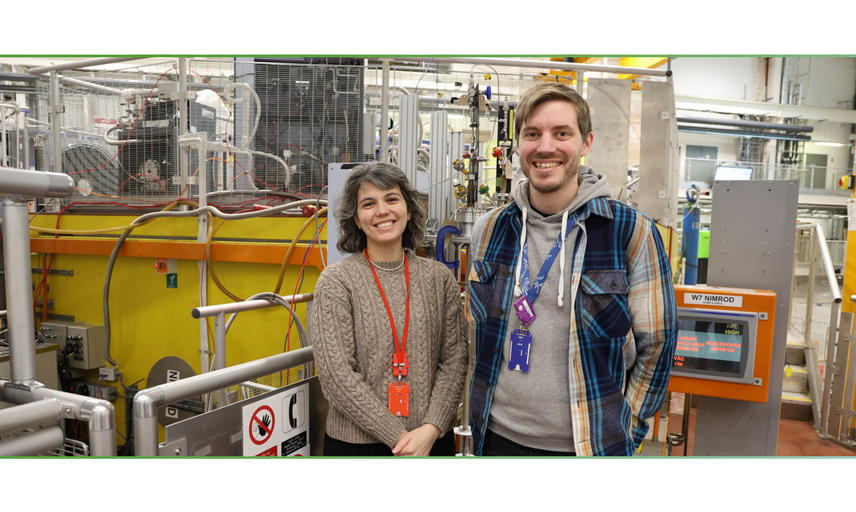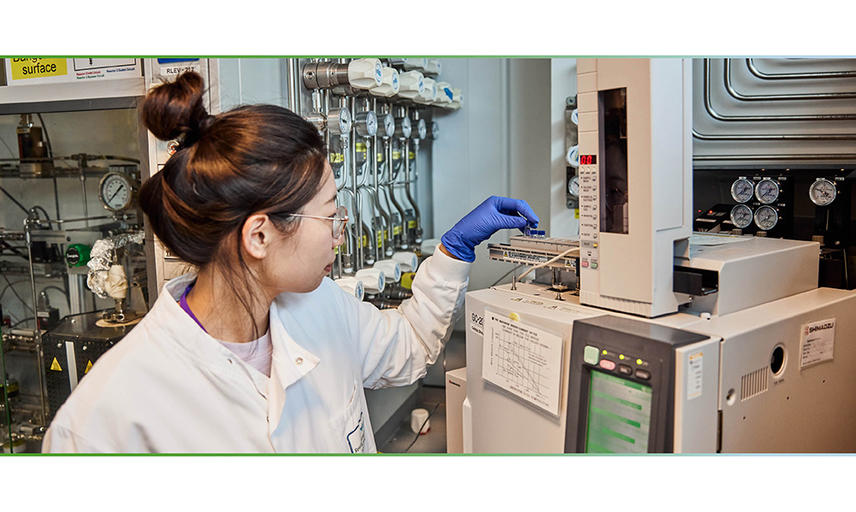Exploitation of Facilities
Image credit: Central Laser Facility
image credit: UKRI STFC, ISIS Neutron and Muon Source
Central Laser Facility lab. Image credit: CLF, STFC
© Research Complex at Harwell. Photographer: David Fisher.
A key component of the work of the Hub has been its strong relationships with the world leading facilities on the Harwell campus including the Diamond Light Source, the ISIS Neutron and Muon Source and more recently the Central Laser Facility (CLF); where work of the Hub team has not only led to the growing and successful use of the facilities in catalytic science, but has also contributed to their development.
Johnson Matthey have also played an instrumental role in helping to introduce the CLF to catalysis and are putting in £15k of support for an in situ cell to do FLIM (via Naomi Omori’s iCASE project) and have supported Andy Beale’s Kerr Gated Raman and FLIM proposals. They provided funding for Andy Beale to build an in situ Kerr Gated Raman cell. Johnson Matthey also helped to support the catalysis work at ISIS too and sponsored Alex O’MAlley (£10k) to work on QENS for catalysis and have collaborated with Stewart Parker and David Lennon in this area extensively via the two iCASE projects running on INS and QENS.
Notable achievements include:
Here the Catalysis Hub in association with Diamond has led a highly successful Block allocation Group (BAG) on the Core XAFS beamline and has supported more than 20 research groups across ten institutions including new users. This access to beam time has resulted in more than 32 publications. The hub has also developed a number of in situ analysis techniques including operando XAFS/DRIFTS technique. The uses of in situ and operando spectroscopic methods are important for investigating and developing improved catalyst materials. This project aimed to develop a combined XAFS/DRIFTS system where the local structure and oxidation state information provided by X-ray Absorption fine structure (XAFS) and surface sensitive information obtained from FTIR. This powerful combination of techniques has been demonstrated by the study of the restructuring of a bimetallic AuPd/Al2O3 catalyst during CO oxidation the structural changes affect the activity and are shown in the Figure. This powerful combination of techniques is now available for use by the wider UK Catalysis Hub network, and has already been used by several groups to study a variety of catalytic systems. The technique (SpaciFB, Figure 1) has already undergone three phases of testing. 1) investigation of the hydrogen effect promotion of the CO oxidation. 2) The first ever operando structure-activity investigations of Non-Thermal Plasma enhanced catalysts. 3) The spatially resolved investigation of kinetic oscillations during CO oxidation.
A novel and significant development using both DIAMOND and ESRF facilities which has allowed the imaging of real catalytic systems under operando conditions. The approach has been developed to yield 2D cross-sectional information in multimodal mode (i.e. simultaneous acquisition of absorption, fluorescence and diffraction contrast information) as well as in rapid acquisition mode (20 ms per dataset) which allows for a more complete characterisation of functional materials via what has been termed 5D imaging (the imaging in 3 spatial dimensions as a function of time and since each pixel contains a spectrum/pattern we propose the 5th dimension to be the chemistry derived from the interpretation of these data). Some successful applications of this technology includes the observation of subtle differences in Co nanoparticle structure and the correlation with selectivity during Fischer-Tropsch Synthesis at elevated pressures; the observation of the active PtMo state during liquid phase hydrogenation of nitrobenzene and the successful demonstration of 5D imaging to reveal gradients in the type and nature of the active phase during partial oxidation of methane at 700 °C.[1-3] With regards to future developments of the methodology, the proposed lattice upgrades at ESRF and Diamond are expected to yield ~3 orders of magnitude increased brightness and, coupled with improvements in detector performance and data handling means that the quantity and quality of information will improve immensely; some obvious improvements would include sub-micron resolution, sub-second 2D data collection (yielding 5D data in ~ minutes) and the possibility to further develop imaging capabilities using photon-in/photon-out spectroscopies or total scattering.
Beale, RCaH, (UCL) has adapted the techniques of Kerr gated Raman Spectroscopy (KGRS) and Fluorescence Lifetime Imaging (FLIM) for operando catalysis studies. Recent results have demonstrated that KGRS can be used to circumvent the problem of fluorescence in Raman data to either yield time-resolved insight into the possible presence of or else to understand the key stages of hydrocarbon pool species evolution in zeolite materials for methane and methanol conversion respectively; the quality of these spectra (i.e. peak resolution) are such that it is possible to determine conclusively the presence of mechanisms for C3+ vs C6+ formation, against the backdrop of catalyst coking. Corresponding FLIM work has also been employed to study the location and nature of the hydrocarbon deposits so as to put activation and deactivation phenomena into the context of the spatial variation of hydrocarbons across zeolite crystals; importantly the optimal spatial resolution achievable (~ 100 nm) is sufficient to examine the size of zeolite crystals that are typically employed industrially (~ µm).[4] Future developments mostly concern the development of sample environment to reduce reactor ‘dead’ volumes and mitigate localised heating caused by the incident beam; some proposals for this are discussed further in WP3. The applications of Laser techniques for catalysis has also been disseminated to the community via two workshops organised in collaboration with the CLF (Lasers for catalysis, May 2016 and Advanced Characterisation, April 2017).
Techniques especially neutron spectroscopy. Here the hubs strong relationship with ISIS has focused on community engagement, advocacy as well as scientific research through conference and workshops (neutrons for catalysis November 2015) and has led to a large increase in the use of neutron techniques for catalysis. Particularly notable has been the rapid growth in the use inelastic neutron scattering (INS) for in situ spectroscopy and Quasi Elastic Neutron Scattering (QENS) for probing molecular transport. These and other applications are highlighted in a recent special issue of the RSC journal PCCP(http://pubs.rsc.org/en/journals/journalissues/cp#!issueid=cp018026&type=current&issnprint=1463-9076) which was edited by Hub scientists. The Hub is also incentivising instrument upgrades and is the major driver for the proposed catalysis lab within ISIS. And New users to ISIS through the hub include:
- Andrew York, Iain Hitchcock, Paul Collier (Johnson Matthey) – OSIRIS (QENS), collaboration arising from Hub summer event (2 publications
- Robert Raja (Soton) – OSIRIS (QENS), MAPS/TOSCA (INS), collaboration through hub collaboration (2 publications)
- Luids Gomez Hortiguela (ICP -institute of catalysis and petrochemisty, Madrid) – OSIRIS (QENS), Collaboration arising from discussioms at BZA zeolite conference, (publication expected soon)
- Paul Cox (Portsmouth) – OSIRIS (QENS), collaborations intiated from discussions at IZC zeolite conference
Over the last five years we provided high throughput sample environments for both in situ and ex situ XAFS analysis, reactive gas environments for Quasielastic Neutron Scattering and an in situ spatially resolved plug flow reactor for neutron diffraction of liquid phase heterogeneously catalysed reactions with combined liquid phase composition analysis. We are currently working on high pressure and multi capillary reactors for in situ and operando experiments.
The development of The Catalysis Data Infrastructure and The Catalysis Research Workbench will enable further and easier exploitation of stored experimental data and assist in the characterisation or structure solution of catalytic compounds by integrating experimental and computational techniques.
Find out about UK Catalysis Hub Block allocation access (BAG) calls on our BAG page.
References:
- W.T. Price, et al., Sci. Adv. (2017),3.
- W.T. Price, et al., Angew. Chem. Int. Ed. (2015),54 9886-9889.
- Vamvakeros et al. Manuscript in preparation (2017).
- Lezcano-Gonzalez, et al., Angew. Chem. Int. Ed. (2016),55 5215-5219.
For more information about the centre and its research activities please contact
Dr Josie Goodall (josie.goodall@rc-harwell.ac.uk)







